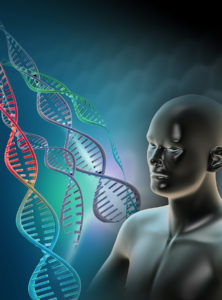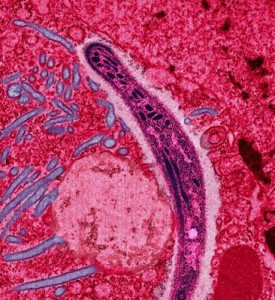 Human ancestors have been found to have intelligence for 3 million years (see post on How Long Have Humans Been Smart). Our particular species, homo sapiens, appeared 200,000 years ago in Africa. This species of modern humans gradually replaced all others starting at 150,000 years, so that by 50,000 only homo sapiens were left. Homo sapiens left Africa in waves over 120,000 years. They spread throughout the entire globe, arriving in the middle east between 120 and 90,000 years ago, then Asia. They arrived in Europe 50,000 years ago, North Asia 20,000 years ago and America 15,000 years ago. Previous ancestors had left Africa over millions of years and also spread out across much of the world. Homo sapiens intermarried with other species such as Neanderthals and Denisovans, before these other species died out.
Human ancestors have been found to have intelligence for 3 million years (see post on How Long Have Humans Been Smart). Our particular species, homo sapiens, appeared 200,000 years ago in Africa. This species of modern humans gradually replaced all others starting at 150,000 years, so that by 50,000 only homo sapiens were left. Homo sapiens left Africa in waves over 120,000 years. They spread throughout the entire globe, arriving in the middle east between 120 and 90,000 years ago, then Asia. They arrived in Europe 50,000 years ago, North Asia 20,000 years ago and America 15,000 years ago. Previous ancestors had left Africa over millions of years and also spread out across much of the world. Homo sapiens intermarried with other species such as Neanderthals and Denisovans, before these other species died out.
It is not clear how much we have evolved during this time. There have been many theories as to why human cognitive ability and language developed, but none are proven. It is not clear how much intelligence has changed during three million years or the last 200,000 years. This post will stick with what is currently scientifically known, not theories.
 Another important question is how much we are evolving right now. This post will discuss current genetic data on what current evolution seems to be taking place.
Another important question is how much we are evolving right now. This post will discuss current genetic data on what current evolution seems to be taking place.
Over the past 10,000 years there has been rapid growth of human populations and much more agriculture. Also, there are more dangerous infections and much greater density of people. Diet and styles of living from increased density helped spur variations of height, immunity, metabolism of fats, lactose intolerance and levels of blood factors such as hemoglobin. Recent studies include genome wide association studies (GWAS).
Unproven genetic theories are frequently offered to the media about complex human traits such as intelligence and its relation to specific genes. There are negative racial theories that are falsely based on genetic variations. Genetic theories related to complex human behavior have not been proven. A previous post on genetic studies related to psychiatric illness demonstrated just how complex it is to find genetic answers for human behavior and mental illnesses. If there are genetic answers, they involve a very large number of interacting genes, regulatory RNAs and epigenetic tags that are beyond current research. Please see the post on Genetics of Psychiatric illness for details.
But, for many reasons it is important to know what has and hasn’t been proven to be recent genetic evolution in human beings. This post will summarize what seems to be actually known about human evolution in the past 10,000 years.
Eating Dairy

About 10,000 years ago cattle were domesticated in the Middle East and North Africa and the demand for adults to drink milk increased. The region of genes called LCT locus are most related to the ability to drink milk without problems. These are for an enzyme lactase that is able to metabolize lactose which is a very prominent sugar in milk. This enzyme normally increases at birth and decreases after weaning of the baby from breast milk in most animals.
But, some groups of people have continued high levels of this lactase enzyme later in life. A genetic variation related to this ability was found in a particular spot (intron 13 of MCM6 upstream of LCT). Other alterations were nearby.
The variant noted in Europeans that keeps the enzyme through adulthood appears to be about 9000 years old. But studies show that the major spread of this variation across Europe occurred around 4000 years ago. Another similar variant occurred in East Africa 5000 years ago. This latter variant is in sync with the fact that there was cattle domestication in the Middle East and East Africa at that time.
There is data that is not yet understood related to genetic alterations in Western Africa and Asia. A group of people in Nigeria (Fulani) have the European type of genetic variation and not the East African type. This group appears to be unique in other ways as well.
Ultra Violet Light and Skin Color
Skin differences are the most obvious changes that have occurred. Ultraviolet light affects the changes of pigme nt in the skin. Genetic variations that cause darker skin at low altitudes and lighter skin at higher altitudes seem to be beneficial. One reason is related to the need for Vitamin D absorption from the skin.
nt in the skin. Genetic variations that cause darker skin at low altitudes and lighter skin at higher altitudes seem to be beneficial. One reason is related to the need for Vitamin D absorption from the skin.
Genetic changes affecting skin are complex. At first genes were located in animals related to the colors of zebrafish and mouse coats. Another early finding related to human albinos. Multiple gene variants have been found in Europeans (including OCA2, TYRP1, TYR, SLC24A5, and SLC45A2). A recent study showed that the light skin of Europeans occurred through a multi factoral genetic variant 4000 years ago. This appears to be related to the entry of new populations at 7000 years ago from near Persia and 4000 years ago from near Ukraine. It is not clear what genes are involved in Africa and Asia and study has only recently begun.
Complex Life in Rainforests
 Rainforests have very high temperature and are very moist. They also have many more microbes such as dangerous bacteria and parasites. People living in these regions have shorter life spans. A big problem is that it is very hard to keep DNA from deteriorating in the topics, so there are few large genetic studies (GWAS).
Rainforests have very high temperature and are very moist. They also have many more microbes such as dangerous bacteria and parasites. People living in these regions have shorter life spans. A big problem is that it is very hard to keep DNA from deteriorating in the topics, so there are few large genetic studies (GWAS).
One adaptation to this environment has been short stature, also known as a “pygmy” type. This is defined as being less that 150 centimeters tall. Many factors seem to affect short stature in the tropics including stress from heat, limited food, immune responses to the greater amount of microbes, and early birth. This change of short stature has occurred in hunter gatherers in South America, Africa and Asia.
 In Africa short stature is very tied to heredity, but there is much mixing of populations. In Central Africa populations, a region of chromosome 3 is associated with Pygmies. One of these genes is DOCK3 that is part of the genetic makeup of Pygmies and other short non Africans. Another gene CISH inhibits a receptor for growth hormone and is related to immune responses. Another gene variant is HESX1 that is related to anterior pituitary that produces growth hormone. Entirely different genetic mechanisms with different regions of genetic changes are related to short stature in Uganda.
In Africa short stature is very tied to heredity, but there is much mixing of populations. In Central Africa populations, a region of chromosome 3 is associated with Pygmies. One of these genes is DOCK3 that is part of the genetic makeup of Pygmies and other short non Africans. Another gene CISH inhibits a receptor for growth hormone and is related to immune responses. Another gene variant is HESX1 that is related to anterior pituitary that produces growth hormone. Entirely different genetic mechanisms with different regions of genetic changes are related to short stature in Uganda.
While African short stature is related to a small set of genes, in Europe there are hundreds of genes that appear to be involved with determining height. In fact, a very small number of these ancient variations can be very relevant. Southern Europeans tend to be shorter than Northern. The genes that influence this difference appear to be ancient movements of migrants from 4000 to 12000 years ago.

Responses to dangerous microbes are a driver of genetic change in humans, especially in the tropics. Recent research shows that immune responses are stronger in people in Africa than Europeans. This appears to be related to changes in genetics of immune responses that came from interbreeding with Neanderthals in Europe more than 50,000 years ago.
Specific genetic alterations in response to microbes are are stronger in the tropics. Malaria is perhaps the most dangerous tropical infection killing more than a million children in Africa a year. Sickle cell genetic variant is one of many genetic variations that alters the response to Malaria. Sickle cell includes many genetic changes including ABO, GYPA, GYPB, GYPE and G6PD. Each of these protect against Malaria in different ways and also cause other diseases such as sickle cell anemia, G6PD deficiency and thalassemia.
There are other variants in the tropics from reactions to microbes. Another from Africa causes kidney disease while protecting against the protozoa that causes “African sleeping sickness” (trypanosome) from the tsetse fly. This genetic change alters the ability to kill the parasite.
Response to Living in Cold
 Inuit people in the arctic regions have unusual genetic variations that help them live in the cold. Genetic variations also help them adjust to a special diet of polyunsaturated fatty acids of the omega-3 type. The difference appears to be genes that affect enzymes related to fatty acids (fatty acid desaturase or FADS).
Inuit people in the arctic regions have unusual genetic variations that help them live in the cold. Genetic variations also help them adjust to a special diet of polyunsaturated fatty acids of the omega-3 type. The difference appears to be genes that affect enzymes related to fatty acids (fatty acid desaturase or FADS).
These genetic changes that help them adapt to this diet, also appear to be related to their having short stature. The short stature might be related to the effects of the fatty acids on growth hormone. There are some of these genes also in a smaller number of Europeans.
Low Oxygen at High Altitude
 If more than 2500 meters above sea level, there is significantly less oxygen and adaptation is necessary. This occurs in Tibet, the Andes, and Ethiopia. People have lived for thousands of years in all three places without problems.
If more than 2500 meters above sea level, there is significantly less oxygen and adaptation is necessary. This occurs in Tibet, the Andes, and Ethiopia. People have lived for thousands of years in all three places without problems.
A pathway related to hypoxia induced factor (HIF) is affected by different genetic changes in the three places. One of these altered genes EGLN1 is the same in people from the Andes and Tibet. Another vital gene for Tibetans affects the HIF pathway in a different place called EPAS1. There are multiple other genes that appear to be related.
Response to Arsenic
 In regions with high arsenic in the water there are adaptions. One such place is in Argentina where people have lived for 11,000 years. Normal metabolism changes arsenic to another molecule and then another (first changes to monomethylarsonic acid or MMA then to dimethylarsinic acid or MDA). The later molecule is not as dangerous as the others. A variation occurred in these people that allows for better metabolism with more of the MDA produces.
In regions with high arsenic in the water there are adaptions. One such place is in Argentina where people have lived for 11,000 years. Normal metabolism changes arsenic to another molecule and then another (first changes to monomethylarsonic acid or MMA then to dimethylarsinic acid or MDA). The later molecule is not as dangerous as the others. A variation occurred in these people that allows for better metabolism with more of the MDA produces.
Complex Diseases
 Since life has changed dramatically for humans over the past 10,000 years, genes that helped long ago, might be detrimental now. There are theories related to this that are not yet clear. Hyped unproven theories include dietary recommendations.
Since life has changed dramatically for humans over the past 10,000 years, genes that helped long ago, might be detrimental now. There are theories related to this that are not yet clear. Hyped unproven theories include dietary recommendations.
One example appears to be related to use of food energy. When it was harder for humans to have enough food, genes that created more energy from food might have been beneficial, but now can possibly increase diabetes. This theory is currently not proven, but is possible.
Some recent data suggests that it might be correct. In Samoa, almost all people are overweight or obese. This is the greatest percentage of obesity known in the world. A new gene was found in Samoans (variant of CREBRF) that affects blood sugar levels and body mass index. This gene variant appears to be greatly increased in the population recently. It is not found in great measure in other places. This gene appears to decrease energy use and increase fat tissues. It is possible that the gene helped against starvation at some point in the past. It is highly associated with type 2 Diabetes.
Genetic Theories and Problems with Current Technology
 The genome project promised to find genetic variations that cause disease. But, in fact, the 2% of the human DNA that are called “genes” did not demonstrate enough variants (mutations) to contribute to understanding many diseases. There are occasional diseases caused by one obvious mutation. One example is Huntington’s disease. But, even knowing the abnormal gene for 25 years has not produced its exact cause or a cure. See post Why is there no cure for Huntingtons. These single alterations are called single nucleotide polymorphisms or SNPs. But the genetic basis of a vast number of diseases are not clear. They could be caused by the vast number of regulatory molecules (RNAs and others) or epigenetic tags on DNA and histones.
The genome project promised to find genetic variations that cause disease. But, in fact, the 2% of the human DNA that are called “genes” did not demonstrate enough variants (mutations) to contribute to understanding many diseases. There are occasional diseases caused by one obvious mutation. One example is Huntington’s disease. But, even knowing the abnormal gene for 25 years has not produced its exact cause or a cure. See post Why is there no cure for Huntingtons. These single alterations are called single nucleotide polymorphisms or SNPs. But the genetic basis of a vast number of diseases are not clear. They could be caused by the vast number of regulatory molecules (RNAs and others) or epigenetic tags on DNA and histones.
 The DNA that is not genes consists of 50% jumping gens (see post) and about 20 to 40% that produces small and large RNAs (see post). These RNAs are vital for regulation of every process in the body. This regulatory RNA is 10 to 20 times more abundant than the RNA that makes proteins. Many diseases appear to be from variations in this RNA.
The DNA that is not genes consists of 50% jumping gens (see post) and about 20 to 40% that produces small and large RNAs (see post). These RNAs are vital for regulation of every process in the body. This regulatory RNA is 10 to 20 times more abundant than the RNA that makes proteins. Many diseases appear to be from variations in this RNA.
But as more is learned about DNA, there are many more factors than previously understood. See the post on increasing genetic complexity. One of these factors is the three dimensional shapes of DNA and where they exist in the nucleus.
But, now it is found that SNPs make up perhaps 5 million base pairs. And another type of DNA called structural variants make up 4 times more or 20 million base pairs. These DNA regions have alterations called duplications, deletions, insertions, inversions, and copy number variants. The function of most are not yet known, but one example includes people who eat a lot of starch. In this group there are many more copy numbers of an enzyme that is used to metabolize starch.
 In fact, these variants are much harder to identify with the current technology used. Only future technology will be able to unravel these. There are other problems with current techniques. One research tool only recognizes newly arising gene changes that rapidly spreads in populations. There is now evidence that there are few of these in the past 200,000 years of human evolution.
In fact, these variants are much harder to identify with the current technology used. Only future technology will be able to unravel these. There are other problems with current techniques. One research tool only recognizes newly arising gene changes that rapidly spreads in populations. There is now evidence that there are few of these in the past 200,000 years of human evolution.
A bigger problem is that most changes involve the addition of multiple genetic alterations at the same time. One known example is the change to white skin in Europe involve a set of new genes at 7000 years ago and then another 4000 years ago. But, in most cases the number of factors is not even known and can be large.
 Another problem is that variants can affect one part of a complex pathway while others change other parts. Understanding these variants involve combing current known of protein production, metabolism and epigenetics at the same time. These fields are just emerging and the combination of all at the same time is beyond current research.
Another problem is that variants can affect one part of a complex pathway while others change other parts. Understanding these variants involve combing current known of protein production, metabolism and epigenetics at the same time. These fields are just emerging and the combination of all at the same time is beyond current research.
Another problem is the dwindling of isolated indigenous populations, which are necessary to trace ancient changes. Another problem is translating animal genetic studies to humans.
Are Humans Evolving Now
 While there is much hype related to current evolution of humans, there is, in fact, very little known. What is known is presented here. Grandiose theories about intelligence and about diets from ancient times are just that. Dietary recommendations are based on little to no data.
While there is much hype related to current evolution of humans, there is, in fact, very little known. What is known is presented here. Grandiose theories about intelligence and about diets from ancient times are just that. Dietary recommendations are based on little to no data.
Genetic processes are more than vastly complex. The number of levels of regulation is vastly complex as is the details of each layer. (see post).
Despite all of these research issues, some human evolution is occurring and more will be discovered as we learn about the overlapping genetic regulation.